Summer Thermal Comfort and Self-Shading Geometries in Passivhaus Dwellings: A Pilot Study Using Future UK Climates
Abstract
:1. Introduction
1.1. The Passivhaus Standard and Literature Review
- Maximum specific space heat demand no more than 15 kWh/m2 of floor area;
- Overall energy demand (including space heating and cooling) no more than 120 kWh/m2;
- Airtightness no more than 0.6 h−1 at 50 Pa;
- For thermal comfort air temperatures in the living areas must not exceed 25 °C for more than 10% of the hours in a given year.
1.2. Future Climate, UK Passivhaus Dwellings and Overheating Risk
1.3. Definition of Thermal Discomfort (Overheating)
1.4. Aims and Objectives
2. Methodology
- Selection of an existing Passivhaus dwelling in the UK
- Modelling and validation of the dwelling’s performance
- Conducting an initial pilot study
- Selecting weather data for simulation
- Defining the risk of overheating
- Selecting the effective façade geometry (tilt angle)
- Implementing the effective design to current and future weather conditions
- Assessing the impact of the introduced geometry to future performance of the Passivhaus
2.1. Reference Case
Occupant Behaviour
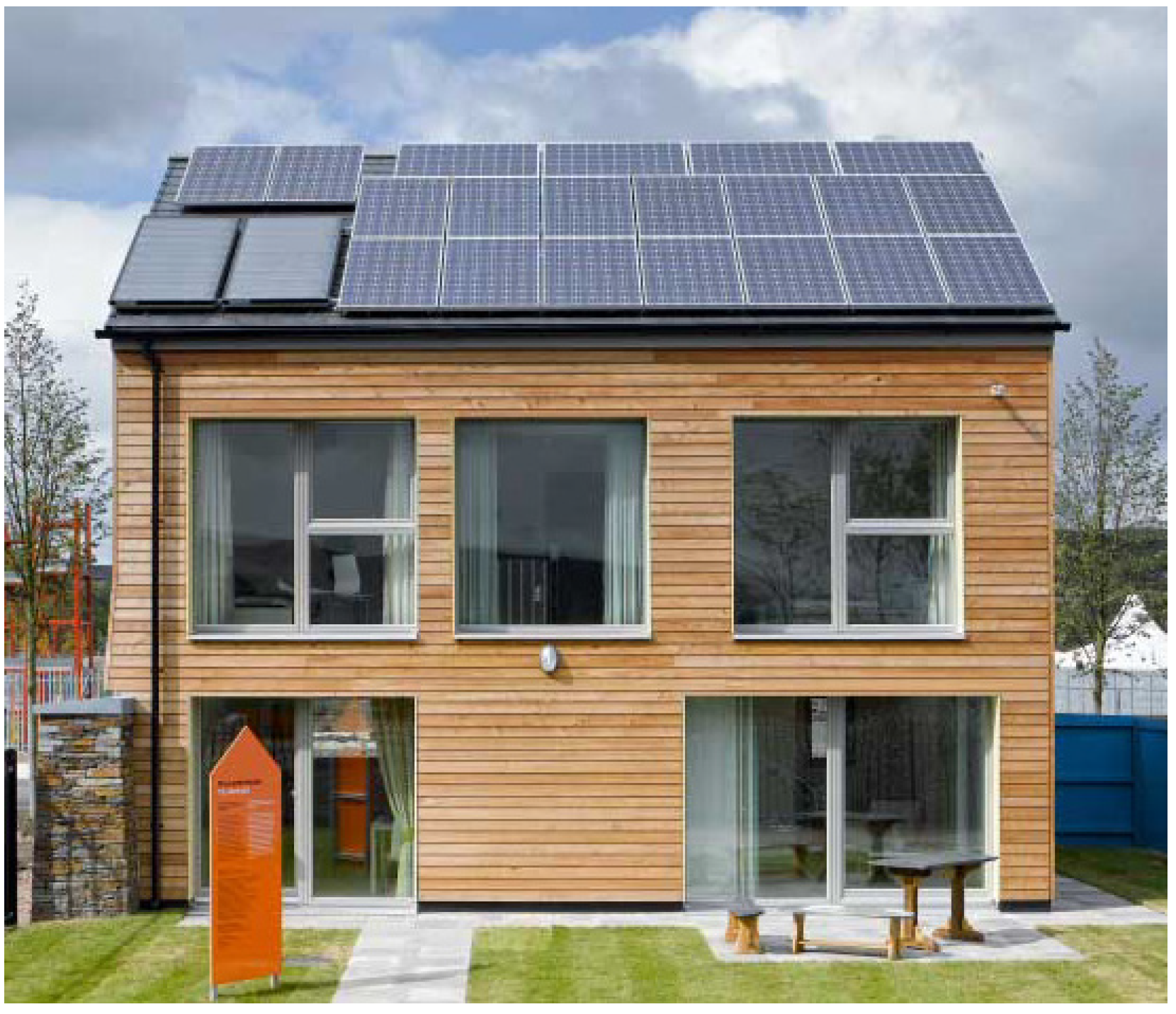
2.2. Modelling and Validation
| Measures | PHPP | Monitored data | DB.1 | DB.2 |
|---|---|---|---|---|
| Annual heating demand (kWh/m2year) | 13 | 9.3 | 9.1 | 13.5 |
| Total Energy requirement including heating (kWh/m2year) | 83 | 189 | 166 | 96 |
| Airtightness (h−1 at 50 Pa) | 0.2 | 0.198 | 0.2 | 0.2 |
| Annual CO2 emission (kg CO2/m2year) | 20.1 | 35.6 | 34.2 | 26.2 |
| Frequency of overheating T > 25 °C, (%) | 6% | 34.9% | 33.1% | 17.5% |
| Measured (kWh) | Larch House |
|---|---|
| Lights | 245 |
| Cooking | 660 |
| Sockets | 3002 |
| Total electricity (PV offset not included) | 4495 |
2.3. Pilot Study
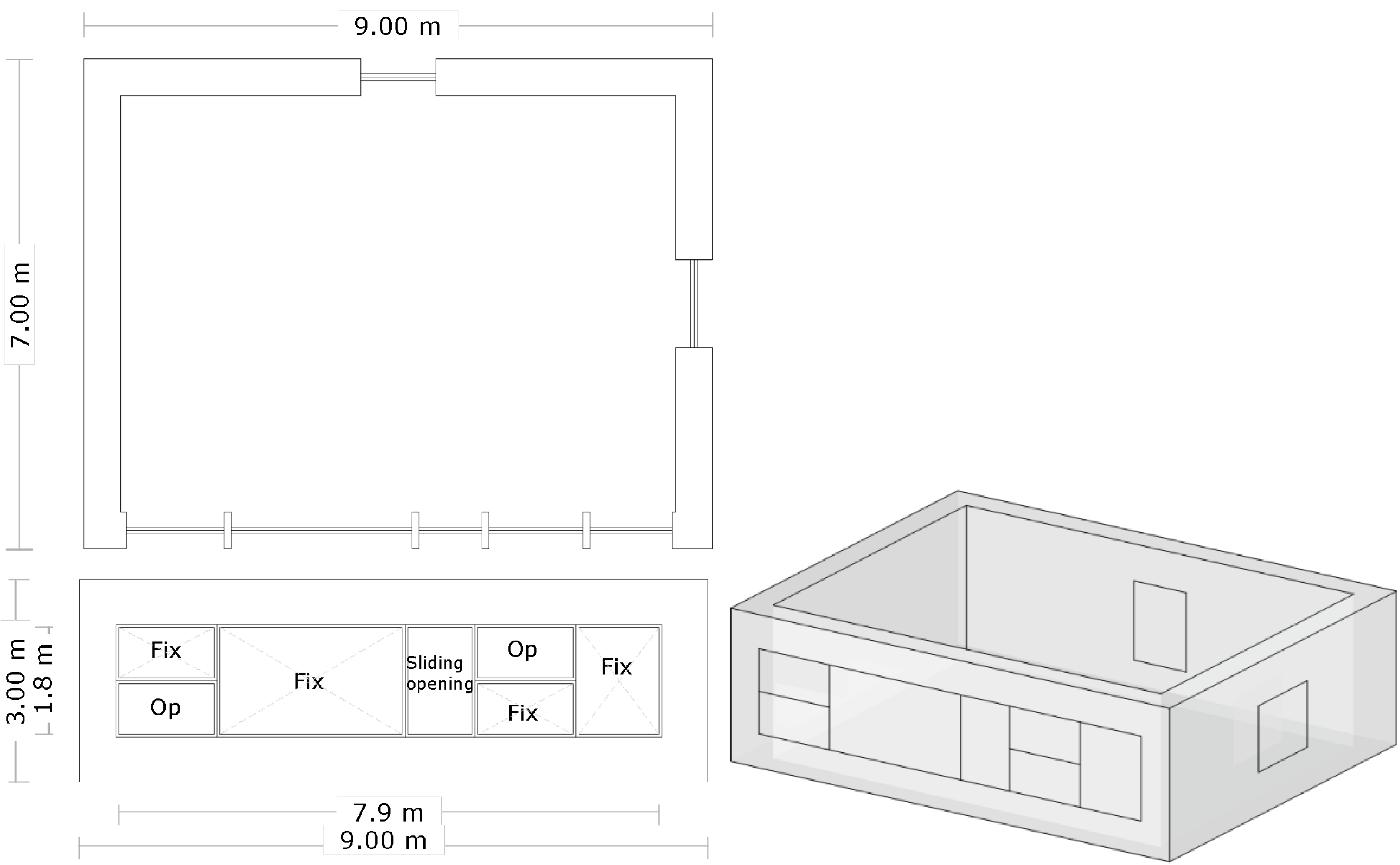

| Element | U-Value (W/m2K) | Thickness (mm) |
|---|---|---|
| Exterior walls | 0.095 | 467 |
| Flat roof | 0.074 | 578 |
| Ground floor slab | 0.076 | 800 |
| Windows | 0.860 | Triple glazing 13 mm argon-filled |
2.4. Weather Data for Simulation
3. Results and Discussion
3.1. Overheating Risk for the Pilot Study Unit in Current and Future Climates in London
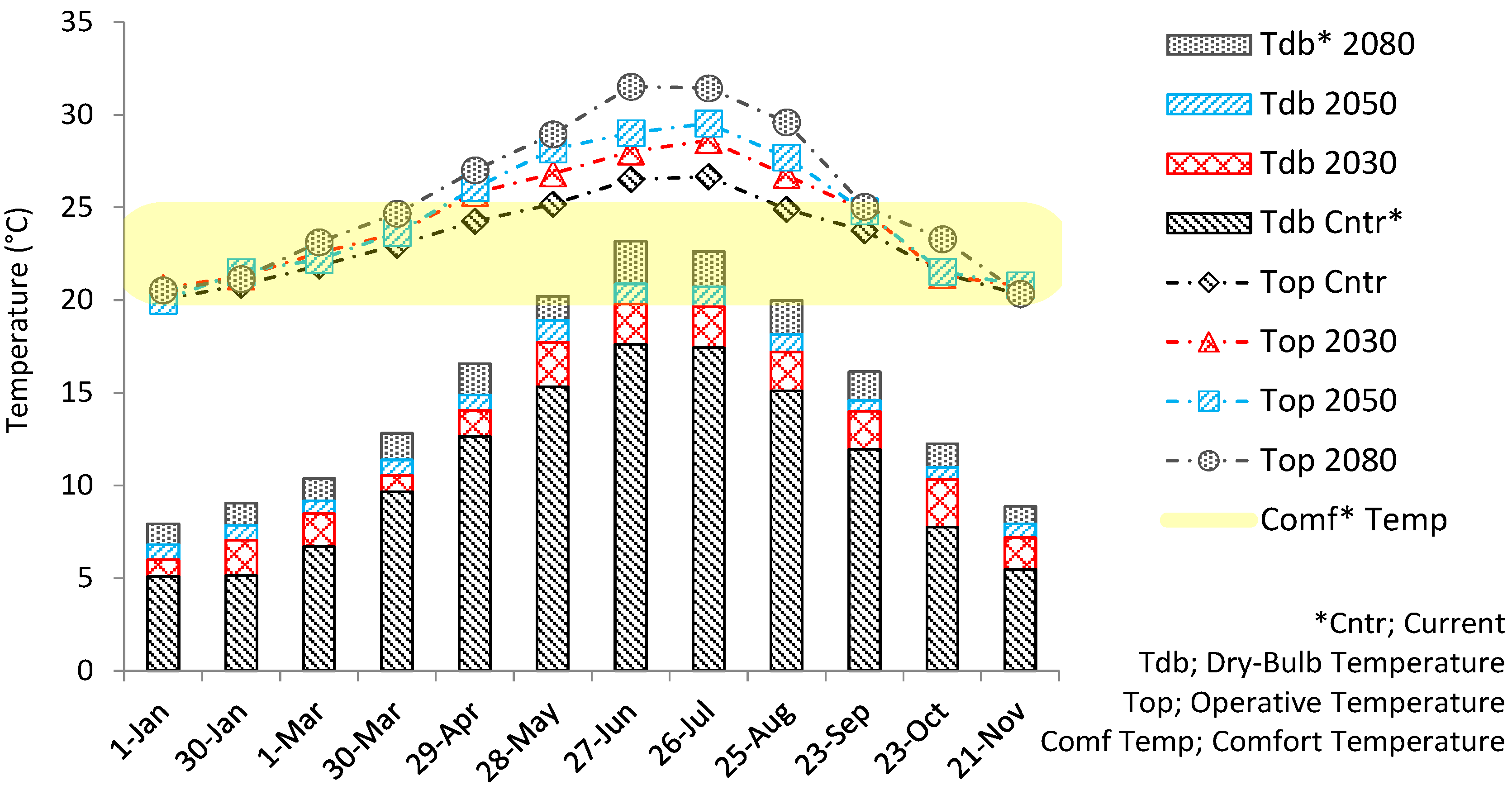
3.2. Effect for the Pilot Study Unit of the Inclined Façade on Heating and Cooling Demand
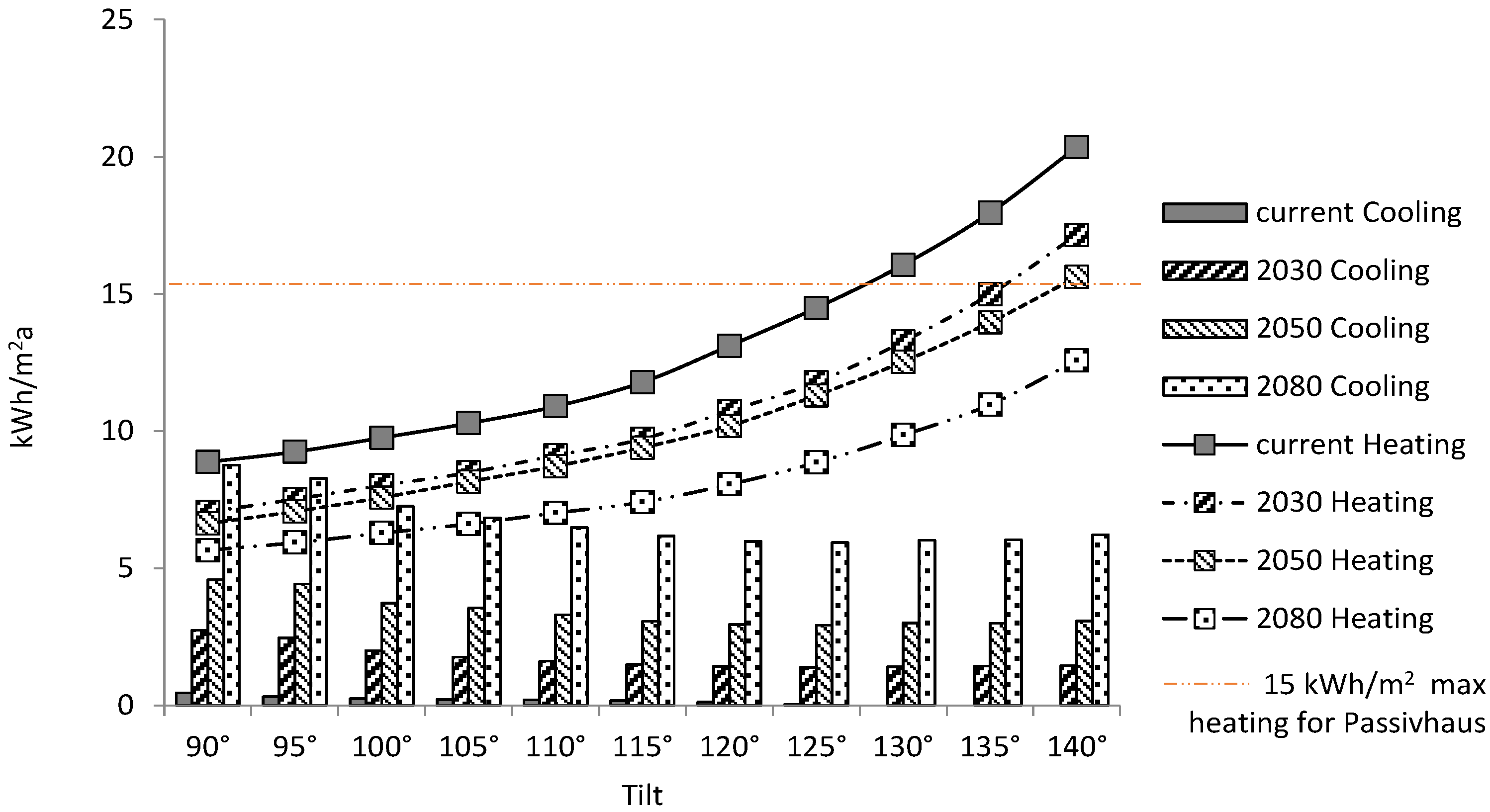
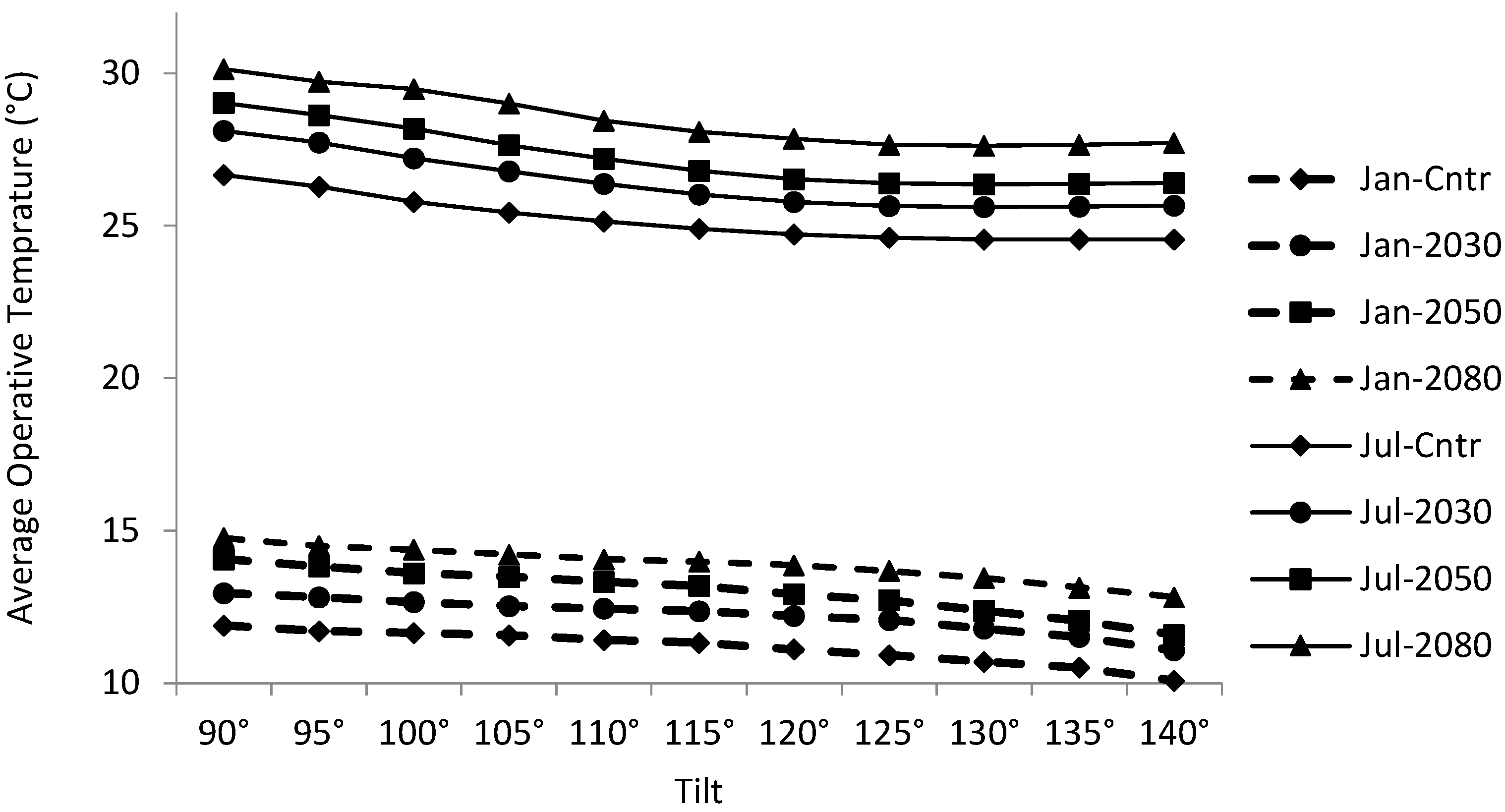
3.3. Overheating Frequency for the Pilot Study Unit

3.4. Implementing for the Pilot Study Unit the Effective Façade Geometry to Current and Future Conditions
4. Effect of the Inclined Façade on Daylighting
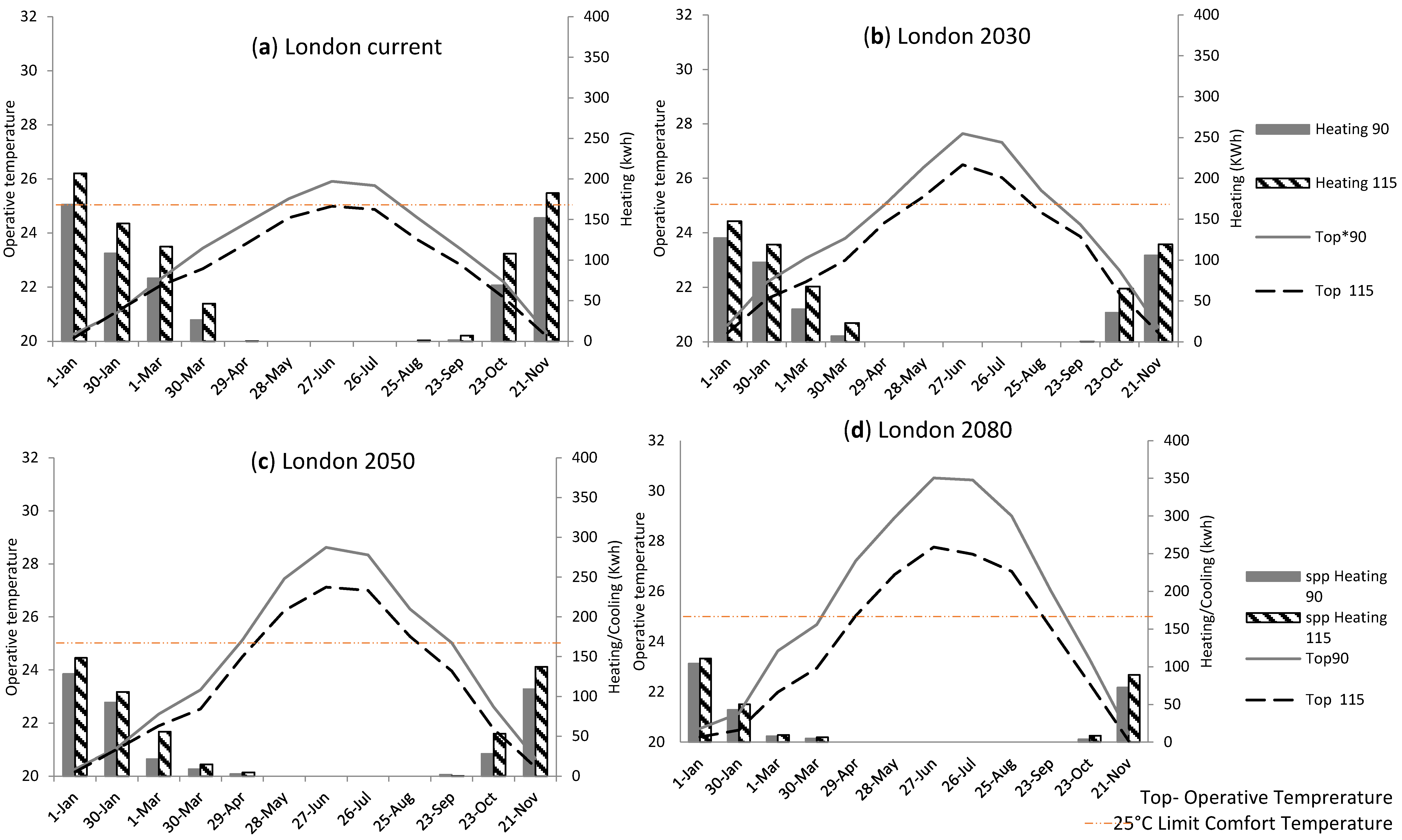
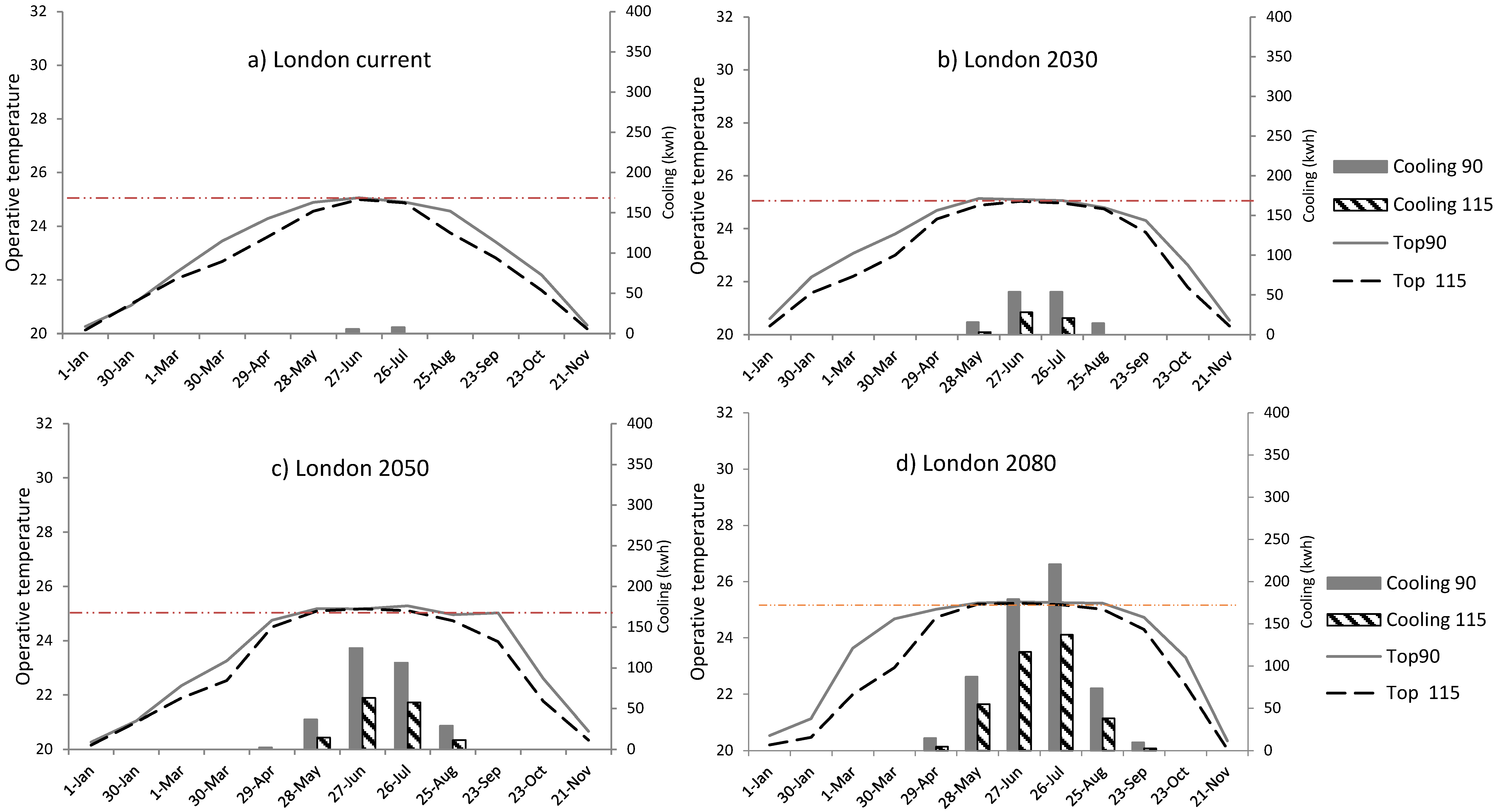
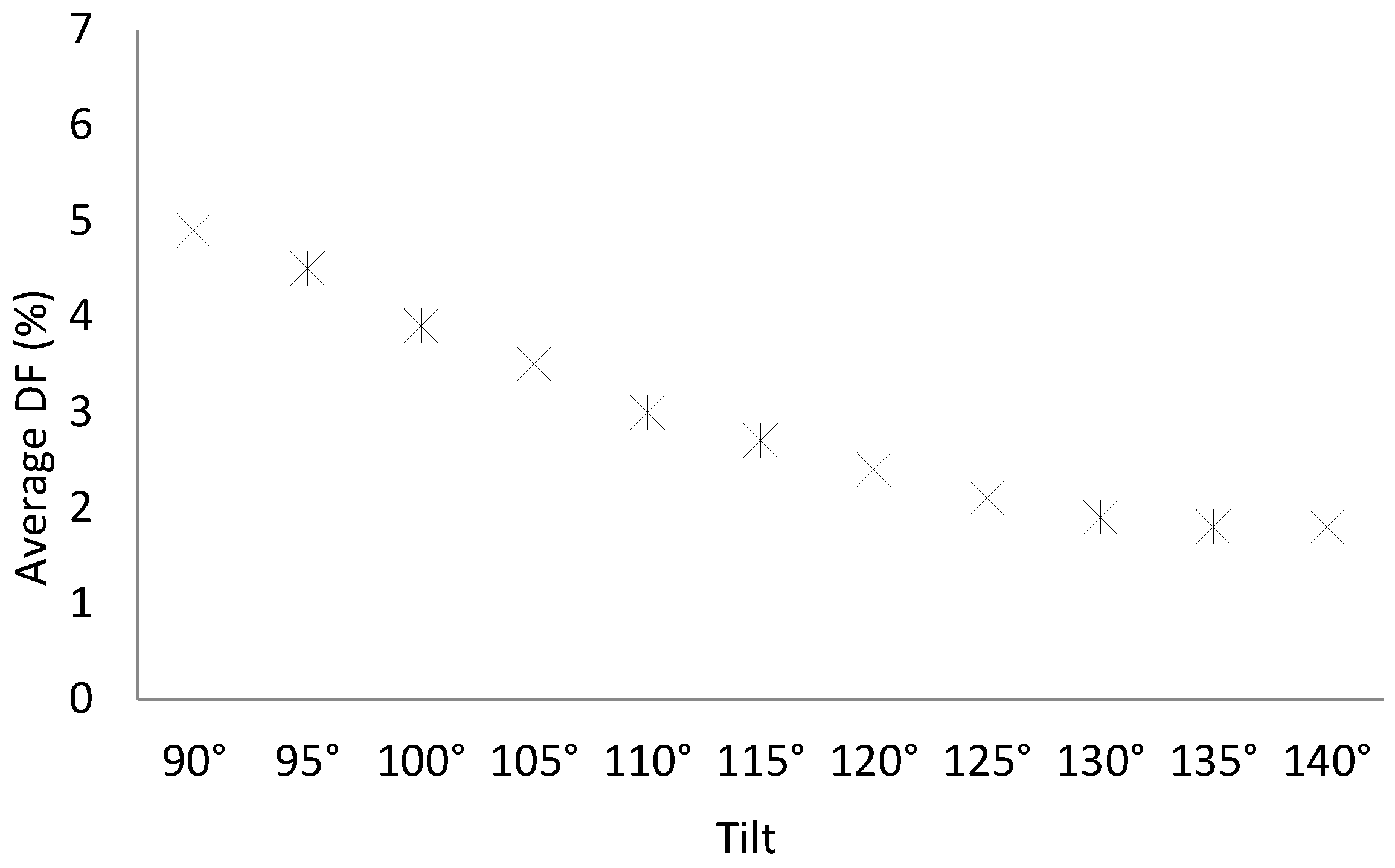
5. Discussion and Future Studies
6. Conclusions
Acknowledgments
Author Contributions
Conflicts of Interest
References
- The Climate Change Act. Available online: http://www.legislation.gov.uk/ (accessed on 23 January 2015).
- James, C.; David, M.; Geoff, S.; Penny, J.; Ben, B.; Kate, B.; Robin, B. UK Climate Projections Science Report; Met Office Hadley Centre: Exeter, UK, 2010. [Google Scholar]
- Kym, M.; Brylewski, R. Passivhaus Primer: Introduction an Aid to Understanding the Key Principles of the Passivhaus Standard; BRE Trust: Watford, UK, 2010. [Google Scholar]
- Passipedia—The Passive House Resource. The Passivhaus Institute: Darmstadt, Germany. Available online: http://passipedia.passiv.de/passipedia_en/basic/Summer (accessed on 23 January 2015).
- McLeod, R.; Mead, K.; Standen, M. Passivhaus Primer: Designer’s Guide: A Guide for the Design Team and Local Authorities; BRE Trust: Watford, UK, 2010. [Google Scholar]
- Feist, W. Passive House Planning Package Version 7; Darmstadt: Rheinstrabe, Germany, 2012. [Google Scholar]
- Orme, M.; Palmer, J.; Irving, S. Control of Overheating in Well-Insulated Housing. In Building Sustainability: Value and Profit; CIBSE: London, UK, 2003. [Google Scholar]
- Tillson, A.-A.; Oreszczyn, T.; Palmer, J. Assessing impacts of summertime overheating: Some adaptation strategies. Build. Res. Inf. 2013, 41, 652–661. [Google Scholar] [CrossRef]
- Mavrogianni, A.; Wilkinson, P.; Davies, M.; Biddulph, P.; Oikonomou, E. Building characteristics as determinants of propensity to high indoor summer temperatures in London dwellings. Build. Environ. 2012, 55, 117–130. [Google Scholar] [CrossRef]
- Piccolo, A.; Simone, F. Effect of switchable glazing on discomfort glare from windows. Build. Environ. 2009, 44, 1171–1180. [Google Scholar] [CrossRef]
- Haldi, F.; Robinson, D. Modelling Occupants’ Presence and Behaviour–Part II. J. Build. Perform. Simul. 2011, 5, 1–3. [Google Scholar]
- Robinson, D.; Haldi, F. Modelling Occupants’ Presence and Behaviour–Part I. J. Build. Perform. Simul. 2011, 4, 301–302. [Google Scholar] [CrossRef]
- Bennet, I.; O’Brien, W.; Gunay, H.B. Effect of Window Blind Use in Residential Buildings: Observation and Simulation Study. In Proceedings of eSIM2014, Ottawa, Canada, 8–9 May 2014.
- Technology Strategy Board. Design for a Future Climate. In Exploiting the Opportunities of Adapting our Buildings; Technology Strategy Board: Swindon, UK, 2011. [Google Scholar]
- Department for Communities and Local Government, The National Archives, 2010. Available online: http://www.communities.gov.uk/documents/planningandbuilding/pdf/1800841.pdf (accessed on 17 February 2015).
- Contribution of Working Groups I, II and III to the Fourth Assessment Report of the Intergovernmental Panel on Climate Change; Pachauri, R.K.; Reisinger, A. (Eds.) IPCC: Geneva, Switzerland, 2007.
- Ridley, I.; Bere, J.; Clarkec, A.; Schwartzb, Y.; Farrd, A. The side by side in use monitored performance of two passiveand low carbon Welsh houses. Energy Build. 2014, 82, 13–26. [Google Scholar] [CrossRef]
- NHBC Foundation; BRE Trust; Zero Carbon Hub. Overheating in New Homes: A Review of the Evidence; IHS BRE Press: Milton Keynes, UK, 2012. [Google Scholar]
- Gupta, R.; Gregg, M. Using UK climate change projections to adapt existing English homes for a warming climate. Build. Environ. 2012, 55, 20–42. [Google Scholar] [CrossRef]
- CIBSE TM48. In Use of Climate Change Scenarios, the CIBSE Future Weather Years; The Chartered Institution of Building Services Engineers: London, UK, 2009.
- Office of the Deputy Prime Minister. Housing Health and Safety Rating System Operating Guidance, Housing Act 2004; Office of the Deputy Prime Minister: London, UK, 2006. [Google Scholar]
- CIBSE. Environmental Design: CIBSE Guide A, 7th ed.; CIBSE: London, UK, 2007. [Google Scholar]
- Dea, R.D.; Brager, G.S. Developing an Adaptive Model of Thermal Comfort and Preference. ASHRAE Trans. 1998, 104, 145–167. [Google Scholar]
- Lomas, K.; Eppel, H. Sensitivity analysis techniques for building thermal simulation programs. Energy Build. 1992, 1, 21–43. [Google Scholar] [CrossRef]
- Vringer, C.; Vringer, C.R. Analysis of the Requirements for Household Consumption. Environ. Assess. Agency 2015, in press. [Google Scholar]
- Gram-Hanssen, K.; Larsen, T.; Knudsen, H.; Kanstrup, A.; Christiansen, E.; Mos-Gaard, M.; Brohus, H.; Heiselberg, P.; Rose, J. Occupants Influence on the EnergyConsumption of Danish Domestic Buildings: State of the Art; Aalborg University: Aalborg, Denmark, 2010. [Google Scholar]
- Ridley, I.; Clarkeb, A.; Bere, J.; Altamirano, H.; Lewis, S.; Durdev, M.; Farr, A. The monitored performance of the first new London dwelling certified to the Passive House standard. Energy Build. 2013, 63, 67–78. [Google Scholar] [CrossRef]
- Bere, J. User Friendly Design; UK Passivhaus Conference: London, UK, 2013. [Google Scholar]
- DesignBuilder Software Ltd. Available online: http://www.designbuilder.co.uk/ (accessed on 7 January 2015).
- DesignBuilder Ltd. EN ISO 13790 Standard (2008) Tests for the Calculation of Energy Use for Space Heating and Cooling; DesignBuilder Ltd.: Stroud, UK, 2012. [Google Scholar]
- ASHRAE. Handbook of Fundamentals, SI ed.; ASHRAE, American Society of Heating, Refrigerating and Air Conditioning Engineers: Atlanta, GA, USA, 2013. [Google Scholar]
- ENERGYPLUS™. The Reference to EnergyPlus Calculations, U.S. Department of Energy: Washington, DC, USA, 2014.
- Mushtaq, A.; Charles, C.H. Uncalibrated Building Energy Simulation Modeling Results. ASHRAE HVAC&R Res. 2006, 12, 1141–1155. [Google Scholar]
- Technology Strategy Board. Building Performance Evaluation. In Use Performance and Post Occupancy Evaluation-Social Housing Passive House Prototypes; Technology Strategy Board: London, UK, 2014. [Google Scholar]
- Bere Architects. Passive House Planning: Worksheet Directory, Passivhaus Varification for Larch House; Bere Architects: London, UK, 2010. [Google Scholar]
- Greater London Authority. London’s Urban Heat Island: A Summary for Decision Makers; GLA: London, UK, 2006. [Google Scholar]
- Yene, A. A method of obtaining visual comfort using fixed shading devices in rooms. Build. Environ. 1999, 2, 85–91. [Google Scholar]
- Carbonari, A.; Rossi, G.; Romagnoni, P. Optimal Orientation and Automatic Control of External Shading Devices in Office Buildings. In Proceedings of the 18th International Conference on Passive and Low Energy, Florianopolis, Brazil, 7–9 November 2001.
- Gugliermetti, F.; Bisegna, F. External Shadings and Glazing Materials as Passive Systems to Improve Energy Consumption and Indoor Comfort in Office Buildings. In Proceedings of the AIVC International Conference, Lyon, France, 23–26 October 2002.
- DesignBuilder Software. DesignBuilder Simulation + CFD Training Guide; DesignBuilder Ltd.: Stroud, UK, 2011. [Google Scholar]
- The Energy Saving Trust. Solid Wall Insulation Supply Chain Review Purple Market Research for the Energy Saving Trust and the Energy Efficiency Partnership for Homes; The Energy Saving Trust: London, UK, 2009. [Google Scholar]
- Porritt, S.; Cropper, P.; Shao, L.; Goodier, C. Ranking of interventions to reduce dwelling overheating during heat waves. Energy Build. 2012, 55, 16–27. [Google Scholar] [CrossRef]
© 2015 by the authors; licensee MDPI, Basel, Switzerland. This article is an open access article distributed under the terms and conditions of the Creative Commons Attribution license (http://creativecommons.org/licenses/by/4.0/).
Share and Cite
Lavafpour, Y.; Sharples, S. Summer Thermal Comfort and Self-Shading Geometries in Passivhaus Dwellings: A Pilot Study Using Future UK Climates. Buildings 2015, 5, 964-984. https://doi.org/10.3390/buildings5030964
Lavafpour Y, Sharples S. Summer Thermal Comfort and Self-Shading Geometries in Passivhaus Dwellings: A Pilot Study Using Future UK Climates. Buildings. 2015; 5(3):964-984. https://doi.org/10.3390/buildings5030964
Chicago/Turabian StyleLavafpour, Yahya, and Steve Sharples. 2015. "Summer Thermal Comfort and Self-Shading Geometries in Passivhaus Dwellings: A Pilot Study Using Future UK Climates" Buildings 5, no. 3: 964-984. https://doi.org/10.3390/buildings5030964
APA StyleLavafpour, Y., & Sharples, S. (2015). Summer Thermal Comfort and Self-Shading Geometries in Passivhaus Dwellings: A Pilot Study Using Future UK Climates. Buildings, 5(3), 964-984. https://doi.org/10.3390/buildings5030964





